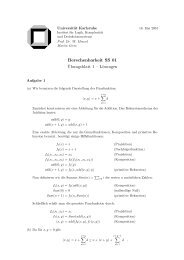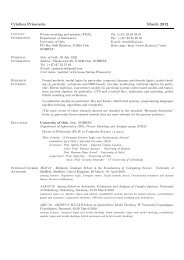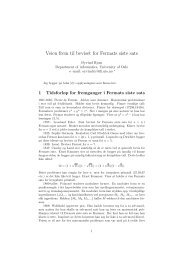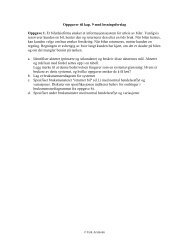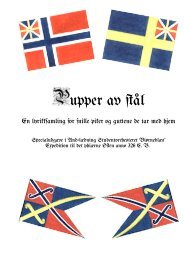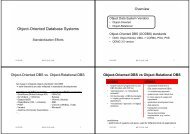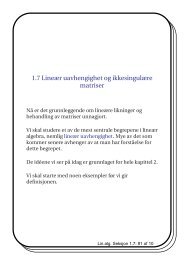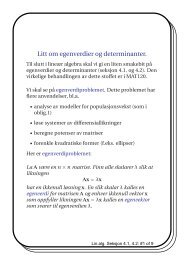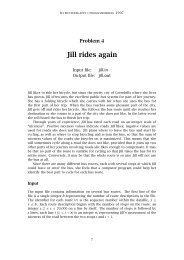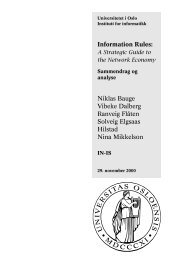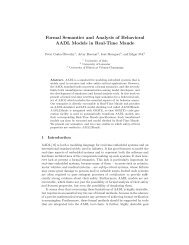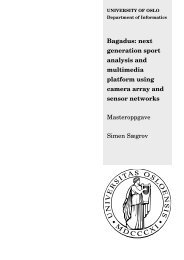Timed CTL Model Checking in Real-Time Maude⋆ - IfI
Timed CTL Model Checking in Real-Time Maude⋆ - IfI
Timed CTL Model Checking in Real-Time Maude⋆ - IfI
You also want an ePaper? Increase the reach of your titles
YUMPU automatically turns print PDFs into web optimized ePapers that Google loves.
8 D. Lepri, E. Ábrahám, and P. Cs. Ölveczky<br />
Def<strong>in</strong>ition 1. Given a set Π of atomic propositions, T<strong>CTL</strong> formulae are built<br />
us<strong>in</strong>g the follow<strong>in</strong>g abstract syntax:<br />
ϕ ::= true | p | ¬ϕ | ϕ ∧ ϕ | E ϕ UI ϕ | A ϕ UI ϕ<br />
where p ∈ Π and I is a time <strong>in</strong>terval.<br />
We omit the bound [0, ∞) as subscript and we write ≤ b, < b, ≥ a and > a for<br />
[0, b], [0, b), [a, ∞) and (a, ∞), respectively. We denote by T<strong>CTL</strong>cb the fragment<br />
of T<strong>CTL</strong> where all time bounds are of the form [a, b] with a < b, or [a, ∞).<br />
3.2 <strong><strong>Time</strong>d</strong> Kripke Structures and T<strong>CTL</strong> Semantics<br />
The semantics of T<strong>CTL</strong> formulae is def<strong>in</strong>ed on Kripke structures. A Kripke<br />
structure is a transition system with an associated label<strong>in</strong>g function, which maps<br />
each state <strong>in</strong> the transition system to the set of atomic propositions that hold<br />
<strong>in</strong> that state.<br />
A timed Kripke structure is a Kripke structure where each transition has the<br />
form s r<br />
−→ s ′ , where r denotes the duration of the transition step.<br />
Def<strong>in</strong>ition 2. Given a set of atomic propositions Π and a time doma<strong>in</strong> T , a<br />
timed Kripke structure is a triple T K = (S, T<br />
−→, L) where S is a set of states,<br />
T<br />
−→⊆ S×T ×S is a transition relation with duration, and L is a label<strong>in</strong>g function<br />
L : S → P(Π). The transition relation T<br />
−→ is total, 4 i.e., for each s ∈ S there<br />
exist r ∈ T , s ′ ∈ S such that (s, r, s ′ ) ∈ T<br />
−→. We write s r<br />
−→ s ′ if (s, r, s ′ ) ∈ T<br />
−→.<br />
We use a similar notation for timed paths <strong>in</strong> a timed Kripke structure T K as for<br />
r0 r1<br />
real-time rewrite theories. Thus, a timed path is written π = t0 −→ t1 −→ . . .,<br />
we def<strong>in</strong>e dπ m = m−1 i=0 ri, tπ m = tm and rπ m = rm, and the set of all timed fair<br />
paths orig<strong>in</strong>at<strong>in</strong>g <strong>in</strong> state t is denoted by tfPathsT K(t).<br />
The semantics of T<strong>CTL</strong> formulae is def<strong>in</strong>ed as follows:<br />
Def<strong>in</strong>ition 3. For timed Kripke structures T K = (S, T<br />
−→, L), states t ∈ S, and<br />
T<strong>CTL</strong> formulae ϕ, the po<strong>in</strong>twise satisfaction relation T K, t |=p ϕ is def<strong>in</strong>ed<br />
<strong>in</strong>ductively as follows:<br />
T K, t |=p true always.<br />
T K, t |=p p iff p ∈ L(t).<br />
T K, t |=p ¬ϕ1 iff T K, t |=p ϕ1.<br />
T K, t |=p ϕ1 ∧ ϕ2 iff T K, t |=p ϕ1 and T K, t |=p ϕ2.<br />
T K, t |=p E ϕ1 UI ϕ2 iff there exists π ∈ tfPaths T K(t) and an <strong>in</strong>dex k s.t.<br />
d π k ∈ I, T K, tπ k |=p ϕ2, and<br />
T K, t π l |=p ϕ1 for all 0 ≤ l < k.<br />
T K, t |=p A ϕ1 UI ϕ2 iff for each π ∈ tfPaths T K(t) there is an <strong>in</strong>dex k s.t.<br />
d π k ∈ I, T K, tπ k |=p ϕ2, and<br />
T K, t π l |=p ϕ1 for all 0 ≤ l < k.<br />
4 T<br />
T • T<br />
A transition relation −→ can be made total by def<strong>in</strong><strong>in</strong>g ( −→) = −→ ∪{(s, 0, s) ∈<br />
S × T × S | ¬∃ s ′ ∈ S, r ∈ T s.t. (s, r, s ′ ) ∈ T<br />
−→}.



